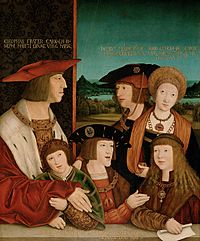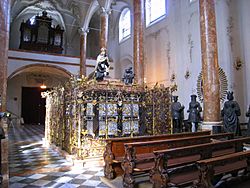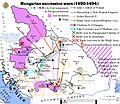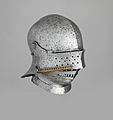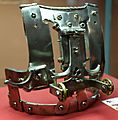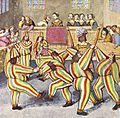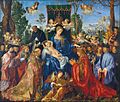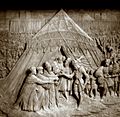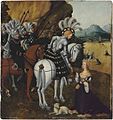Maximilian I, Holy Roman Emperor facts for kids
Quick facts for kids Maximilian I |
|
|---|---|
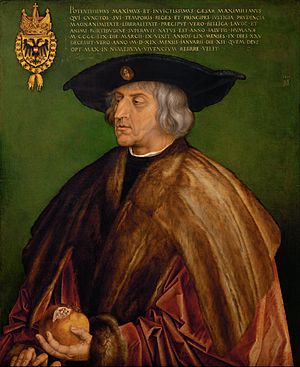
Portrait by Albrecht Dürer, 1519 (Kunsthistorisches Museum, Vienna). Maximilian holds his personal emblem, the pomegranate.
|
|
| King of Germany (King of the Romans) | |
| Reign | 16 February 1486 – 12 January 1519 |
| Coronation | 9 April 1486 |
| Predecessor | Frederick III |
| Successor | Charles V |
| Holy Roman Emperor, Archduke of Austria | |
| Reign | 19 August 1493 – 12 January 1519 |
| Predecessor | Frederick III |
| Successor | Charles V |
| Duke of Burgundy | |
| Reign | 5 January 1477 – 27 March 1482 |
| Predecessor | Mary the Rich |
| Successor | Philip IV |
| Burial | Wiener Neustadt, Austria |
| Spouse | Mary, Duchess of Burgundy Anne of Brittany{annulled} Bianca Maria Sforza |
| Issue | Philip I of Castile Margaret, Archduchess of Austria |
| House | House of Habsburg |
| Father | Frederick III |
| Mother | Eleanor of Portugal |
Maximilian I (born March 22, 1459 – died January 12, 1519) was a powerful ruler from the House of Habsburg. He was the son of Frederick III, Holy Roman Emperor and Eleanor of Portugal, Holy Roman Empress. Maximilian became King of the Romans in 1486 and then Holy Roman Emperor in 1493. He ruled alongside his father for about ten years before becoming Emperor.
Maximilian was very skilled at increasing his family's power. He did this through both wars and smart marriages. For example, he arranged for his son Philip to marry Joanna of Castile, a Spanish princess. This led to his grandson, Charles, ruling both the Holy Roman Empire and the huge Spanish Empire. This made the Habsburg family incredibly powerful across Europe. However, Maximilian also lost some Austrian lands in what is now Switzerland to the Swiss Confederacy.
Contents
Early Life and Family Background
Maximilian was born in Wiener Neustadt, Austria, on March 22, 1459. His father was Frederick III, Holy Roman Emperor, and his mother was Eleanor of Portugal, Holy Roman Empress.
At that time, the Dukes of Burgundy were very respected rulers. Charles the Bold, the Duke of Burgundy, was a main rival of Maximilian's father, Frederick III. Frederick was worried about Burgundy expanding its lands near the Holy Roman Empire. To stop this, he tried to arrange a marriage between Charles's only daughter, Mary, and his son Maximilian. He succeeded after a long fight called the Siege of Neuss (1474–75). Maximilian and Mary were married on August 16, 1477.
Ruling in Burgundy and the Netherlands
Mary inherited a huge amount of land in France and the Low Countries when her father died in the Battle of Nancy on January 5, 1477. Even before he became King of the Romans in 1486, Maximilian was determined to keep these lands for his family, the House of Habsburg.
The French king, Louis XI, also claimed the Duchy of Burgundy. He fought against the Habsburgs for these lands. Maximilian defended his wife's territories and defeated the French army at Guinegatte on August 7, 1479.
The marriage contract between Maximilian and Mary said that only their children could inherit their lands, not the surviving parent. However, Mary promised to give her lands to Maximilian if she died. Mary sadly died in a riding accident on March 27, 1482, near Wijnendale Castle. After her death, Maximilian's main goal was to make sure their son, Philip the Handsome, inherited everything.
Some parts of the Netherlands did not like Maximilian. They signed a treaty with King Louis XI in 1482. This treaty forced Maximilian to give up two regions, Franche-Comté and Artois, to France. Maximilian continued to rule Mary's remaining lands for his young son, Philip. Later, in the Treaty of Senlis (1493), Maximilian and the new French king, Charles VIII, exchanged these two territories for Burgundy and Picardy. This meant that much of the Netherlands stayed under Habsburg control.
Ruling the Holy Roman Empire
| Holy Roman Emperor |
|---|
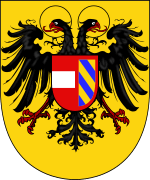 |
|
|
Maximilian was chosen as King of the Romans on February 16, 1486, in Frankfurt am Main. He was crowned on April 9, 1486, in Aachen. When his father died in 1493, Maximilian became the head of the Holy Roman Empire.
Wars in Italy and Switzerland
After the Treaty of Senlis settled differences with France, the French king, Louis XII, turned his attention to Italy. He claimed the Duchy of Milan. In 1499, he conquered Milan and forced its ruler, Lodovico il Moro, to leave. This created a conflict with Maximilian, who had married Bianca Maria Sforza, a daughter of the Duke of Milan, in 1494. However, Maximilian could not stop the French from taking Milan. This led to the long Italian Wars, where Maximilian joined the Holy League to fight against the French.
Italy was not Maximilian's only problem. The Swiss won a big victory against the Empire in the battle of Dornach on July 22, 1499. Maximilian had to agree to a peace treaty on September 22, 1499, in Basel. This treaty gave the Swiss Confederacy independence from the Holy Roman Empire. Maximilian is sometimes called "The Last Knight."
Important Reforms
Inside the Holy Roman Empire, Maximilian faced pressure from other rulers. They felt that his wars to increase his family's power were not good for everyone. However, everyone agreed that the Empire needed big changes to stay united. These changes began at the 1495 Reichstag (a type of parliament) in Worms.
A new court, the Reichskammergericht, was created. It was mostly independent from the King. To pay for it, a new tax called the Gemeine Pfennig was started, but it was never fully collected. The rulers also wanted more independence from the King. This led Maximilian to agree to create an organization called the Reichsregiment. This group would meet in Nürnberg and include representatives from the King, other rulers, and different social classes. However, this new group did not have much power, and Maximilian regained control in 1502.
Because of these challenges, Maximilian also made changes within his own Habsburg lands. He wanted to create a more unified state, similar to the Burgundian system. This was not entirely successful, but it led to the creation of three main regions: Lower Austria, Upper Austria, and Vorderösterreich.
In 1508, Maximilian, with the Pope's permission, took the title of Erwählter Römischer Kaiser ("Elected Roman Emperor"). This ended the old tradition that the Holy Roman Emperor had to be crowned by the Pope.
Tu felix Austria nube (Happy Austria, Marry!)
As part of a treaty, Maximilian's three-year-old daughter, Margaret, was promised to the French prince (who later became Charles VIII). She was sent to France to be raised there. However, Charles VIII later broke off this engagement to marry Anne of Brittany. Anne had actually been engaged to Maximilian himself! Charles and his sister wanted Anne's lands for France. So, Charles invaded Brittany, forced Anne to end her engagement to Maximilian, and married her. Margaret eventually returned to her father in 1493 and married twice more.
In 1493, Maximilian married again, this time to the daughter of the Duke of Milan. This led to more wars with France. Maximilian used his own marriages and those of his children to expand his family's power against France. After 1500, he focused on arranging marriages for his grandchildren, looking towards Eastern Europe.
To reduce pressure on the Empire and secure lands like Bohemia and Hungary for the Habsburgs, Maximilian met with the Jagiellonian kings of Hungary and Poland in Vienna in 1515. They arranged for Maximilian's granddaughter, Mary, to marry Louis, the son of the Hungarian king. They also arranged for Louis's sister, Anne, to marry Maximilian's grandson, Ferdinand. Both grandchildren were the children of Maximilian's son, Philip the Handsome, and Juana la Loca of Castile. These marriages brought Hungary and Bohemia under Habsburg rule in 1526.
These clever political marriages were summed up in a famous Latin saying: Bella gerant aliī, tū fēlix Austria nūbe/ Nam quae Mars aliīs, dat tibi regna Venus, which means, "Let others wage war, but you, O happy Austria, marry; for those kingdoms which the god of war gives to others, the goddess of love gives to you."
Death and Lasting Impact
In 1501, Maximilian had a bad fall from his horse, which injured his leg and caused him pain for the rest of his life. Some historians believe he became very sad in his later years. From 1514, he even traveled everywhere with his coffin.
Maximilian died in Wels, Austria, on January 12, 1519. His grandson, Charles V, became Emperor after him, as Maximilian's son Philip had died in 1506. Maximilian is buried in the Castle Chapel at Wiener Neustadt. There is also a special empty tomb (a cenotaph) for him in the Hofkirche, Innsbruck.
Maximilian loved arts and sciences. He supported scholars and artists like Albrecht Dürer and Albrecht Altdorfer. His reign saw the beginning of the Renaissance in Germany. He ordered huge woodblock prints like The Triumphal Arch and a Triumphal Procession.
Maximilian was also very passionate about armour. He saw it not just for battle but as an art form. The style of armor popular during his time, with its detailed metalwork, became known as Maximilian armour. This armor focused on the shape of the metal itself, rather than etched designs. Maximilian even gave a strange jousting helmet to King Henry VIII of England. It looked like a human face with a grin, ram's horns, and even brass spectacles!
Maximilian had appointed his daughter, Margaret, to govern the Netherlands and to raise his grandsons, Charles and Ferdinand. She did a great job. Through wars and marriages, Maximilian expanded the Habsburg family's power in many directions: to the Netherlands, Spain, Bohemia, Hungary, Poland, and Italy. This influence lasted for centuries and shaped much of European history.
Titles
Maximilian I held many titles, including: Elected Holy Roman Emperor, King of Germany, of Hungary, Archduke of Austria, Duke of Burgundy, Brabant, Lorraine, Styria, Carinthia, Carniola, Limburg, Luxembourg, Gelderland, Landgrave of Alsace, Prince of Swabia, Count Palatine of Burgundy, Count of Habsburg, Hainaut, Flanders, Tyrol, Holland, and many more.
Marriages and Children
Maximilian was married three times, but only his first marriage had children:
- Mary of Burgundy (1457–1482): They married in Ghent on August 18, 1477. Mary died in a riding accident in 1482. They had three children:
* Philip the Handsome (1478–1506): He inherited his mother's lands but died before his father. He married Joanna of Castile and was the father of the Holy Roman Emperors Charles V and Ferdinand I. * Margaret of Austria (1480–1533): She was first engaged to the French prince, Charles VIII of France, but he broke it off. She later married John, Prince of Asturias and then Philibert II of Savoy. She also took care of her brother Philip's children and governed Burgundy. * Francis of Austria (born and died in 1481).
- Anne of Brittany (1477–1514): They were married by proxy in 1490, but the marriage was cancelled by the Pope in 1492. Anne was then forced to marry the French King, Charles VIII.
- Bianca Maria Sforza (1472–1510): They married in 1493. This marriage brought Maximilian a lot of money and helped him claim his rights over Milan. They had no children, and the marriage was not happy.
Maximilian is also believed to have had a daughter named Margareta (1480–1537) with Margareta Von Edelsheim.
Images for kids
-
Maximilian offers Mary of Burgundy an engagement ring. Miniature from a medieval manuscript. Ca. 1485–1515.
-
Succession wars in Hungary after the death of Matthias Corvinus.
-
Sallet (helmet) of Maximilian I, around 1490–95, at the Metropolitan Museum of Art.
-
The arsenal in Lindau. Construction started in 1507.
-
Ensisheim meteorite, National Museum of Natural History, France.
-
Maximilian in the last year of his life, holding his personal emblem, a pomegranate. Portrait by Albrecht Dürer, 1519.
See also
 In Spanish: Maximiliano I de Habsburgo para niños
In Spanish: Maximiliano I de Habsburgo para niños




